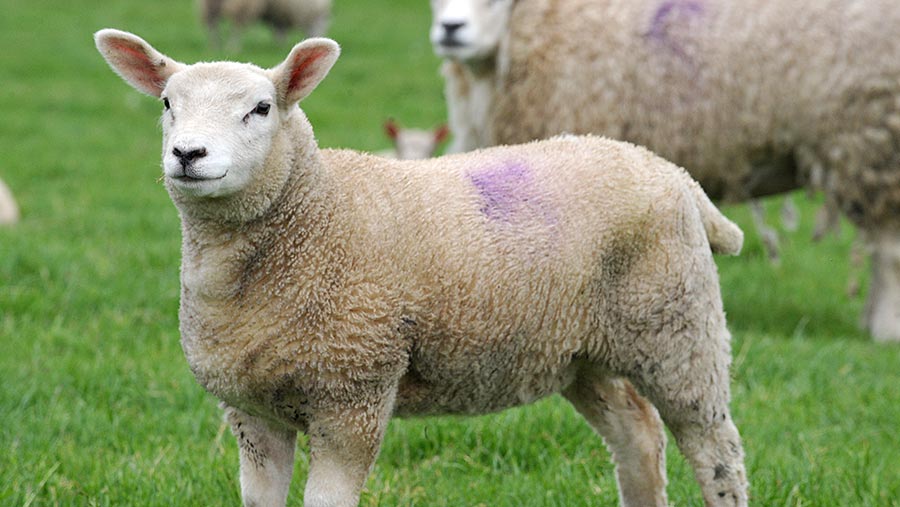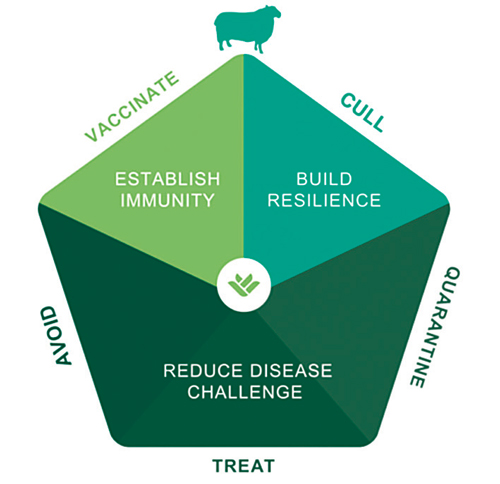Step-by-step guide to foot-bathing sheep

Many farmers wrongly believe routine foot-trimming helps control lameness and promotes better mobility.
But it can actually spread bacteria and exacerbate lameness prevalence within flocks.
This is also true of foot-bathing, unless it is carried out correctly. Below we get advice on how to ensure your foot-bathing protocol is effective and find out why foot-trimming is only appropriate in certain circumstances.
See more articles on sheep lameness:
- Sheep lameness: The successes and remaining challenges
- 4 ways to reduce sheep lameness to less than 2% by 2021
- How a sheep farmer has reduced lameness by 28%
- Advice on how to vaccinate sheep against foot-rot
- Step-by-step guide to foot-bathing sheep
- Should you trim sheep’s feet to control lameness?
- Advice for quarantining incoming sheep to prevent lameness
- How sheep farmer has reduced lameness to just 3%
1. View foot-bathing as a method of disinfection and not as a lameness cure
Foot-bathing has its place when trying to manage scald, especially in lambs and ewes with lambs at foot. However, it is not a cure and could potentially cause more harm than good if it is done badly.
Foot-bathing should be thought of as a method of disinfection, especially when sheep have been gathered in a small area following shearing or scanning, for example.
See also: How to correctly diagnose and treat the main causes of sheep lameness
Gathering sheep creates an increased risk of infection, but sometimes it is unavoidable. When you have a group of sheep in a confined area, you should run them through a foot-bath post-gathering.
However, don’t gather sheep just to foot-bath them, as you are increasing their risk of infection.
Ewes with clinical foot-rot or contagious ovine digital dermatitis (CODD) need systemic treatment instead of foot-bathing.
Using formalin on ewes with CODD can be very painful due to exposed soft tissue.
2. Choose a chemical you can use well
There is not a vast amount of evidence comparing different agents. The most important thing is to choose a chemical you can use well.
For example, if you are using a 10% zinc sulphate solution to manage foot-rot, sheep need to stand in the product for up to 30 minutes for it to be effective.
If you are unable to do this, then you would be better off using a product they can walk through, such as a 3% formalin solution.
There is no point using a standing product as a walk-through, as you are simply wasting your money.
Antibiotic foot-baths should not be used. Instead, it is better to target systemic antibiotics treatment in infected animals preventing treatment of healthy animals and mitigating any concerns of bath disposal.
FAI Five-Point Plan

3. Use the chemicals correctly
Dilution rate
Know the volume of your foot-bath so you can work out the correct dilution for the product you are using. If you are not sure how to do this, your animal health adviser, Suitably Qualified Person (SQP) or vet can help.
If it is too diluted it will not be effective, but if the solution is too concentrated it can cause painful burns, especially with formalin.
Muddy feet
Some products are inactivated when they meet organic material such as the mud on sheep’s feet. If you are soiling the foot-bath and rendering the chemical inactive, you are creating a “bacterial soup” and it may exacerbate things.
To overcome this, you can use a freshwater foot-bath before the chemical foot-bath to get rid of any organic material.
Some people use straw in the bottom of a foot-bath or a mat to encourage lambs to go through. Again, these may inactivate the chemical and undo its value.
Allow enough standing time post bathing
Most chemicals need to dry for them to be effective. This means leaving sheep’s feet to dry for at least 20 minutes on a hard, concrete standing before returning to grass.
This can be very hard to operate, but if you don’t do this, you may be wasting the chemical on the pasture.
Refilling the foot-bath
The frequency of change will vary depending on the product, size of foot-bath and how many sheep are being treated. Always refer to the product data sheet.
Health and safety and disposal
There are acknowledged health and safety risks with formalin, with concerns about potential carcinogenic properties.
It’s important you are aware of the health and safety risks of the chemical; wear correct personal protective equipment and use the products in a well-ventilated space.
Products must be disposed of according to the data sheet.
Sponsor’s message

Through July and into August, MSD Animal Health, together with Farmers Weekly, will be highlighting how the FAI Five-Point Plan (5PP) gives sheep farmers a clear framework for managing lameness effectively. We will bring together recommendations from key stakeholders in the sheep farming community to provide best practice guidance and a range of practical tips.
Adoption of the 5PP will maintain progress towards the industry target of achieving <2% lameness (as per FAWC 2011) in the national flock by 2021. Widespread adoption of the 5PP will also help reduce the amount of antibiotics used by the sheep industry by at least 10% in line with the RUMA Targets Task Force 2017 recommendations.
For a healthy view of a sound flock, follow the Five-Point Plan:
- Cull – to build flock resilience
- Treat, Quarantine and Avoid – to reduce the disease challenge
- Vaccinate – to establish immunity
Further detailed advice and support is available from vet practices and SQPs in animal health trade outlets.
Thanks to MSD Animal Health, whose sponsorship made it possible to run the Sheep Lameness Roundtable 2019. Farmers Weekly had complete editorial control of this report.
